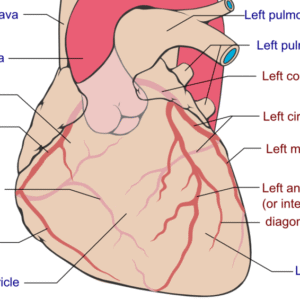Cardiology > Congenital Heart Disease in Adults
Congenital Heart Disease in Adults
Background
Congenital Heart Disease (CHD) in adults refers to structural heart defects present from birth that persist into adulthood or are discovered later in life. While some patients undergo corrective or palliative surgery in childhood, others may remain undiagnosed until adulthood. Advancements in pediatric cardiology have led to increased survival, resulting in a growing population of adults with repaired or unrepaired CHD. These patients may experience long-term sequelae, including arrhythmias, heart failure, and complications from prior surgical interventions.
II) Classification/Types
By Anatomic Lesion:
- Acyanotic Lesions
- Atrial Septal Defect (ASD)
- Ventricular Septal Defect (VSD)
- Patent Ductus Arteriosus (PDA)
- Coarctation of the Aorta
- Pulmonary Stenosis
- Atrioventricular Septal Defect
- Cyanotic Lesions
- Tetralogy of Fallot
- Transposition of the Great Arteries
- Truncus Arteriosus
- Total Anomalous Pulmonary Venous Return
- Eisenmenger Syndrome
By Surgical History:
- Repaired CHD: Corrective surgery performed in childhood (e.g., VSD closure, tetralogy repair)
- Palliated CHD: Non-curative interventions (e.g., Fontan procedure)
- Unrepaired CHD: Lesions undiagnosed or untreated into adulthood
Pathophysiology
The hemodynamic burden in adult CHD results from left-to-right shunts, right ventricular overload, pressure gradients across obstructive lesions, or cyanosis due to right-to-left shunting. Long-standing defects may cause pulmonary hypertension, arrhythmias, ventricular dysfunction, or heart failure. Surgical scars or conduit placements can lead to residual lesions, rhythm disturbances, or device-related complications.
Epidemiology
- Over 1.4 million adults live with CHD in the U.S.
- The adult CHD population now exceeds the pediatric population due to improved survival
- Atrial septal defects are the most common lesions diagnosed in adulthood
- Women and men are affected equally, though pregnancy adds complexity for females
Etiology
I) Causes
- Congenital developmental anomalies of the heart or great vessels during embryogenesis
- May be isolated or part of genetic syndromes (e.g., Down syndrome, DiGeorge syndrome)
II) Risk Factors
- Family history of CHD
- Genetic syndromes (e.g., Turner, Noonan, Marfan)
- Maternal factors: Diabetes, rubella, teratogen exposure during pregnancy
Clinical Presentation
I) History (Symptoms)
- Fatigue, exertional dyspnea
- Cyanosis or clubbing (in cyanotic lesions)
- Palpitations or syncope (due to arrhythmias)
- Chest pain or signs of heart failure
- History of murmur or prior surgery in childhood
- Stroke or paradoxical embolism (in ASD/PFO)
II) Physical Exam (Signs)
- Cardiac murmurs (e.g., systolic murmur in VSD)
- Cyanosis, digital clubbing
- Elevated jugular venous pressure
- Differential BP in arms and legs (coarctation)
- Peripheral edema, hepatomegaly in heart failure
Differential Diagnosis (DDx)
- Acquired valvular heart disease
- Cardiomyopathies
- Intracardiac shunt (PFO, ASD)
- Pulmonary hypertension
- Eisenmenger syndrome
- Pericardial disease
Diagnostic Tests
Initial Evaluation
- ECG: Axis deviations, conduction blocks, atrial enlargement
- Chest X-ray: Cardiomegaly, pulmonary vasculature abnormalities
- Transthoracic echocardiography (TTE): First-line for structural evaluation
- Pulse oximetry: Detects hypoxia or desaturation
Advanced Imaging
- Transesophageal echocardiography (TEE): Superior for septal defects, posterior structures
- Cardiac MRI: Gold standard for evaluating complex anatomy and RV function
- Cardiac CT: Useful for vascular structures, post-surgical anatomy
- Cardiac catheterization: Hemodynamic assessment and shunt quantification
- Bubble study (with echo): Identifies intracardiac shunts like PFO
Treatment
I) Acute Management
- Stabilize symptoms (e.g., oxygen, diuretics for heart failure)
- Manage arrhythmias or embolic events
- Initiate anticoagulation for stroke prevention in ASD or atrial fibrillation
II) Chronic Management
- Surgical or percutaneous closure of defects (e.g., ASD, VSD, PDA)
- Balloon angioplasty or stenting for coarctation
- Pacemaker/ICD for conduction abnormalities
- Fontan revision or heart transplant in advanced failure
Medications
Drug Class | Examples | Notes |
Diuretics | Furosemide | For volume overload and heart failure |
ACE Inhibitors | Lisinopril | Afterload reduction in ventricular dysfunction |
Beta-blockers | Metoprolol, Atenolol | For arrhythmia control, RV outflow tract issues |
Anticoagulants | Warfarin, Apixaban | For embolism prevention in septal defects or AF |
Pulmonary Vasodilators | Sildenafil, Bosentan | For Eisenmenger syndrome |
Device Therapy
- Pacemakers for sinus node dysfunction or heart block
- ICDs for secondary prevention of sudden cardiac death
- Ventricular assist devices or transplant in end-stage heart failure
Patient Education, Screening, Vaccines
- Encourage adherence to lifelong cardiology follow-up
- Discuss endocarditis prophylaxis when indicated
- Preconception counseling for women with CHD
- Vaccinate against influenza and pneumococcus
- Educate about signs of worsening heart failure or arrhythmias
Consults/Referrals
- Adult congenital cardiology specialist: For ongoing care
- Electrophysiology: For rhythm evaluation and device therapy
- Cardiothoracic surgery: For surgical repairs
- Genetics: For syndromic or familial cases
- Obstetrics/Maternal-Fetal Medicine: For pregnancy planning
Follow-Up
Short-Term
- Post-procedural imaging (e.g., post-ASD closure)
- Monitor for arrhythmias and heart failure symptoms
- Adjust medications based on clinical status
Long-Term
- Annual or biennial echocardiography depending on lesion complexity
- Lifelong follow-up with congenital heart disease specialist
- Monitor for complications of prior surgeries (e.g., conduit stenosis, arrhythmias)
Prognosis
- Varies by defect type and surgical outcome
- Excellent prognosis in simple, corrected lesions
- Complex CHD or cyanotic heart disease has higher morbidity
- Late complications include heart failure, arrhythmias, and pulmonary hypertension
- Lifelong surveillance and timely interventions improve outcomes
Stay on top of medicine. Get connected. Crush the boards.
HMD is a beacon of medical education, committed to forging a global network of physicians, medical students, and allied healthcare professionals.

